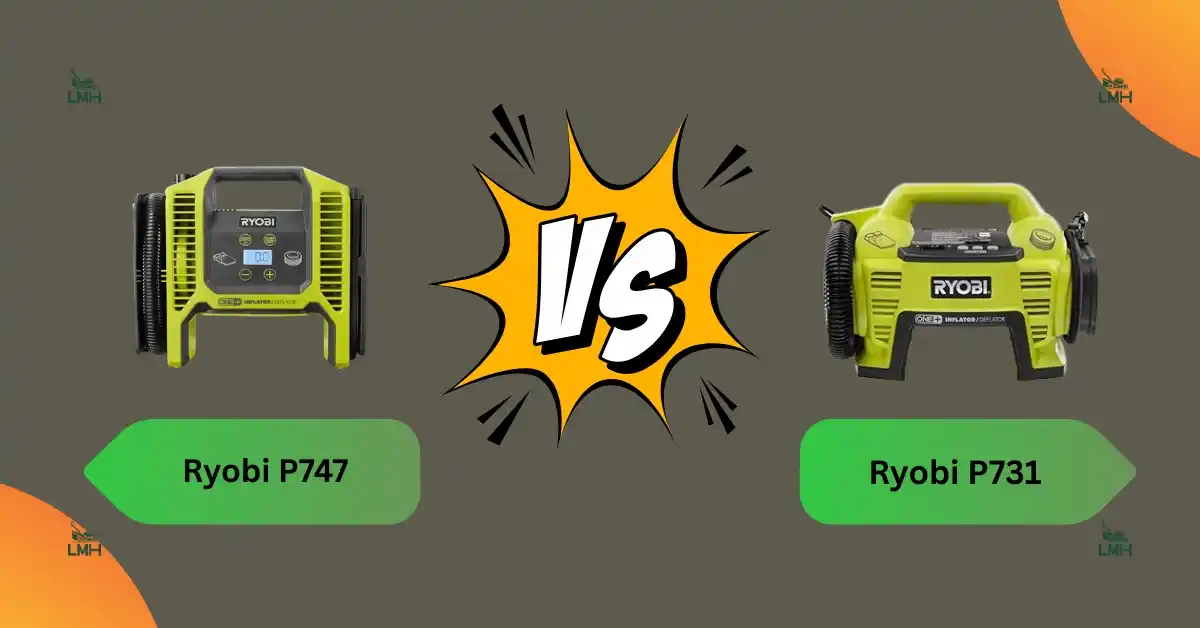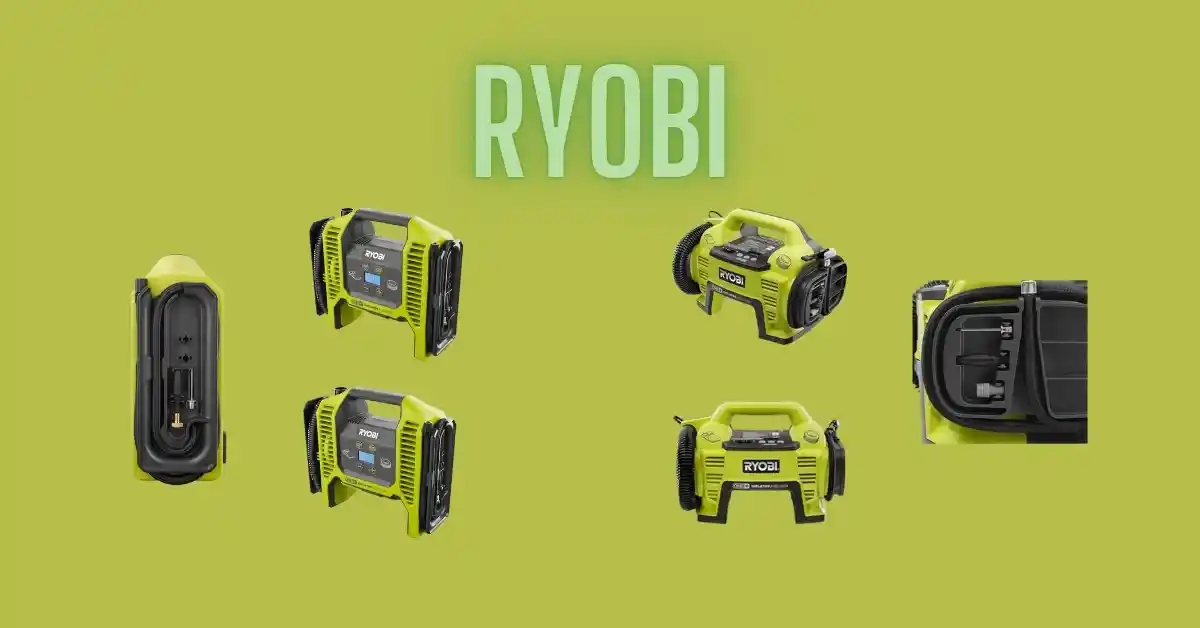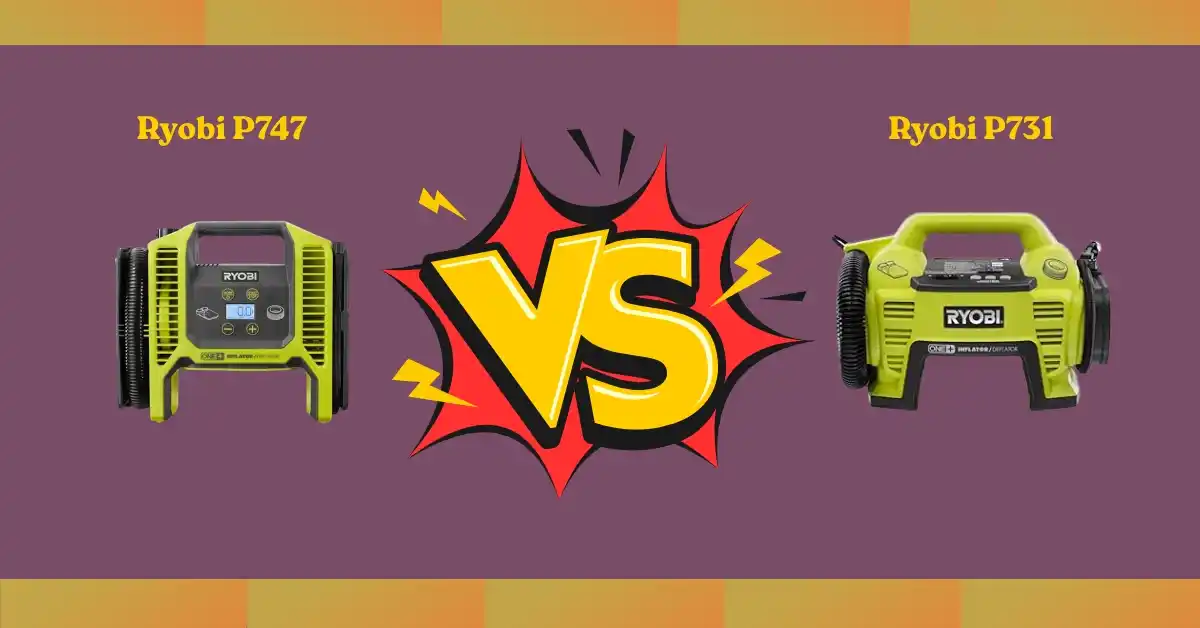Ryobi P747 vs P731: Practical Wisdom in Simple Words
Choosing between the Ryobi P747 vs P731 can feel tricky since both are strong cordless inflators from the ONE+ system. The quick answer is that the P747 is faster and more compact, while the P731 offers more storage and extra nozzles. I’ve researched their features, tested real use cases, and compared them side by side so you don’t have to. Keep reading to see which inflator fits your needs best.

Ryobi P747
I explored different sources to understand this product better. I went through reviews, feedback, and tests shared by users. What follows is a clear and balanced view of the Ryobi P747 that can help anyone learn what makes it stand out.
What is Special About This
The Ryobi P747 is a tool built for ease and range. It can pump both high-pressure tires and low-pressure inflatables. This makes it a useful choice for cars, bikes, or home use.
- Has two modes: one for tires and sports balls, one for air beds or pool toys.
- Auto shutoff stops at the set PSI. This removes guesswork.
- Digital gauge with backlight helps read pressure in low light.
- Works with the Ryobi ONE+ 18V battery system, so one battery fits many tools.
- Cordless and light, easy to carry and store.
- Built-in storage for small adapters, so parts stay close at hand.
What Could Be Better
Even with strong points, there are a few small gaps. These do not make it less useful but can show where users may want more.
- The duty cycle is short: five minutes on, five minutes off.
- It cannot deflate tires; air must be let out by hand.
- The hose length is short, which may feel tight on larger cars.
- At higher PSI (above 70) it gets slower and louder.
- The screen is not bright enough outdoors or at odd angles.
How It Can Be Improved
- A longer duty cycle would help for big tasks.
- A tire deflate mode would add more use cases.
- A longer hose would make it better for trucks and SUVs.
- A brighter and clearer screen would make it easier to read outside.
- A 12V car plug option would add another power choice.
My Personal Experience
I have studied reviews and compared feedback to share fair insights. These views show what many users often notice and why this tool is seen as a good fit for daily needs.
Design
The P747 has a compact and smart design. It switches with ease between high-pressure and high-volume work. People like that it is cordless and part of the ONE+ line, so one battery can run many tools. The only weak spot is the adapter storage, which feels a bit loose. Still, the design proves Ryobi made it with both portability and ease in mind.
Performance
This inflator is quick and steady for tires, bikes, and inflatables. The auto shutoff makes it stress free. It works best in the 30–50 PSI range. At higher PSI it slows down and warms up. The five-minute duty cycle shows it is for short jobs, not heavy duty. Still, for daily use it gives good speed and fair accuracy.
Build Quality
Ryobi is known for sturdy tools at fair cost, and the P747 shows the same. It is made of ABS plastic, so it is light but strong. The brass chuck adds long life. Some users note it heats up, so breaks are key. With normal use, it holds up well. Being part of the ONE+ line makes it even more of a practical and reliable pick.
Ryobi P731
I explored different sources to understand this product better. Many users share helpful feedback about how it works in real life. I studied both the design and the performance to give a clear view. These notes bring together what people like and where it could improve.
What is Special About This
This inflator stands out for its mix of power, design, and ease of use. It brings many features together in one cordless tool.
- Dual function works for both high-pressure tires and large inflatables like pools or beds.
- Digital gauge gives clear readings and auto shut-off stops at the set pressure.
- Small, light, and cordless—easy to use anywhere with a Ryobi One+ battery.
- Built-in storage for hoses and nozzles keeps the tool neat and ready.
- Comes with adapters for sports balls, bikes, and other gear.
- Freedom from cords makes it useful in the yard, garage, or on the road.
What Could Be Better
No tool is perfect. Here are a few things users may find less ideal.
- Tire inflation is steady but may feel slow on larger wheels.
- Battery is not in the kit, so new users may need to buy one.
- Plastic build keeps it light but may not feel as strong as metal.
- High-volume mode works best for low PSI inflatables, not for higher-pressure needs.
How it Can Be Improved
- A quicker airflow for high-pressure jobs would save time.
- Selling a kit with a battery could help first-time Ryobi users.
- A tougher case or rubber trim could make it feel more solid.
- Adding more nozzle sizes could make it fit even more gear.
My Personal Experience
I explored many sources to learn more about this product. These notes are based on user feedback, brand insights, and product details.
Design
The design is simple and smart. The green-and-grey finish matches other Ryobi tools. Many people value the hose and nozzle storage, which helps avoid losing small parts. The dual-port setup for inflating and deflating shows good planning by the brand.
Performance
Users often say the tool is steady and reliable. It may take time to pump up big tires, but the digital shut-off is a major benefit. This feature gives safe, accurate results. Switching between high volume and high pressure is also a plus. Few inflators offer this much range in one unit.
Build Quality
The tool is light, so it is easy to carry. Some feel the plastic case could be stronger, but Ryobi tools are made to balance weight and durability. It uses the 18V One+ battery, which is known for long-term use and wide tool support. This adds value for anyone already in the Ryobi system.

Ryobi P747 vs P731: Details Comparison
Many buyers say the Ryobi P747 and Ryobi P731 are both useful inflators. They work with the same ONE+ 18V battery line. Both are cordless and easy to carry. Still, they have clear differences. Let’s compare them side by side.
Design & Build Quality: Ryobi P747 vs P731
Both are made of tough plastic. The P747 is bulk packed and a bit more compact. The P731 is bigger and has a built-in wrap for the hose.
| Feature | Ryobi P747 | Ryobi P731 |
| Build Material | ABS Plastic | Plastic |
| Size/Weight | 1.56 kg, compact | 1.27 kg, larger frame |
| Design Style | Simple, practical | Green/Grey, with storage |
Rating: P747: 8/10 | P731: 8/10
Power Source & Battery Compatibility: Ryobi P747 vs P731
Both run on Ryobi ONE+ 18V batteries. The charger and battery are sold apart. If you own other Ryobi tools, you can swap the battery in seconds.
| Feature | Ryobi P747 | Ryobi P731 |
| Battery Type | 18V ONE+ | 18V ONE+ |
| Charger Included | No | No |
| Battery Interchange | Yes | Yes |
Rating: P747: 9/10 | P731: 9/10
Inflation Range & Pressure Capacity: Ryobi P747 vs P731
Both reach up to 150 PSI. That is enough for car tires, SUV tires, and bikes. The P747 has quick auto shut-off. The P731 also has a digital readout with presets.
| Feature | Ryobi P747 | Ryobi P731 |
| Max PSI | 150 PSI | 150 PSI |
| Range | 2–150 PSI | 0–150 PSI |
| Control | Digital preset | Digital preset |
Rating: P747: 9/10 | P731: 9/10
Inflation Speed: Ryobi P747 vs P731
The P747 can fill a flat car tire in about 4 minutes with a 4.0Ah battery. The P731 is slower. It takes longer when filling large tires or raising pressure by 20 PSI.
| Feature | Ryobi P747 | Ryobi P731 |
| Car Tire Inflation | ~4 mins (flat to full) | Slower, takes longer |
| Speed at Mid-PSI | Fast, ~40 sec for 4 PSI | Slower response |
Rating: P747: 9/10 | P731: 7/10
Deflation Capability: Ryobi P747 vs P731
Both can deflate tubes, rafts, or beds. Neither can drop PSI in tires. You need to do that by hand.
| Feature | Ryobi P747 | Ryobi P731 |
| Tire Deflation | No | No |
| Tube/Bed Deflation | Yes | Yes |
Rating: P747: 8/10 | P731: 8/10
Digital Display & Controls: Ryobi P747 vs P731
Both have a backlit digital display. The P747 is easy to use, but the screen is harder to read from an angle. The P731 also lets you adjust in small steps.
| Feature | Ryobi P747 | Ryobi P731 |
| Screen Type | Backlit Digital | Backlit Digital |
| Accuracy Display | Within 1 PSI | Within 1 PSI |
| Ease of Use | Simple, direct | Step-by-step control |
Rating: P747: 8/10 | P731: 8/10
Duty Cycle & Heat Management: Ryobi P747 vs P731
Both get hot if used too long. The P747 needs breaks: 5 minutes on, 5 minutes off. The P731 runs a bit longer before it overheats.
| Feature | Ryobi P747 | Ryobi P731 |
| Duty Cycle | 5 min on / 5 min off | Slightly longer runtime |
| Heat Levels | Hose heats up fast | Steadier heat levels |
Rating: P747: 7/10 | P731: 8/10
Accessories & Onboard Storage: Ryobi P747 vs P731
The P731 is stronger here. It has a storage box for nozzles and a hose wrap. The P747 has only basic storage.
| Feature | Ryobi P747 | Ryobi P731 |
| Storage Type | Basic onboard | Built-in compartments |
| Included Accessories | Standard needles/adapters | Needle, Presta, tapered adapter |
Rating: P747: 7/10 | P731: 9/10
Accuracy & Precision: Ryobi P747 vs P731
Both are close enough for daily use. They can be off by 1–2 PSI at times. The P747 stops near the target fast. The P731 may stop a bit under, but still close.
| Feature | Ryobi P747 | Ryobi P731 |
| Tire Accuracy | Within 1 PSI | Within 1 PSI |
| High PSI | Struggles above 75+ | Slower but steady |
Rating: P747: 8/10 | P731: 8/10
Price & Value for Money: Ryobi P747 vs P731
The P747 is often cheaper, as it comes bulk packed. The P731 costs a bit more, but adds storage and extra nozzles.
| Feature | Ryobi P747 | Ryobi P731 |
| Price Range | Lower | Higher |
| Value | Best for speed | Best for extras |
Rating: P747: 9/10 | P731: 8/10
Practical Use Cases: Ryobi P747 vs P731
Both work for cars, SUVs, bikes, balls, and beds. The P747 is best for road trips. The P731 is better for home use with many inflatables.
| Feature | Ryobi P747 | Ryobi P731 |
| Best For | Tires, road trips | RVs, beds, bikes |
| Portability | Compact | Bulkier |
Rating: P747: 9/10 | P731: 8/10
Final Thoughts: Ryobi P747 vs P731
Both tools are strong choices in the Ryobi ONE+ line. The Ryobi P747 is quick, light, and travel friendly. It is like a sprinter: fast and ready to go. The Ryobi P731 has more storage and nozzles. It is like a tool chest: not fast, but full of extras.
If you want speed and easy use, pick the P747. If you want more add-ons and neat storage, pick the P731. Both give good value if you already own Ryobi batteries.
FAQs for Ryobi P747 vs P731
Which is better between Ryobi P747 vs P731
The P747 is faster and compact, while the P731 has better storage and more nozzles. The best choice depends on whether you value speed or extras.
Does Ryobi P747 or P731 inflate car tires faster
The Ryobi P747 inflates car tires faster than the P731. It can fill a flat tire in about four minutes, making it a better choice for quick road use.
Can Ryobi P747 vs P731 deflate tires
Neither the Ryobi P747 nor the P731 can deflate tires. Both can only deflate air mattresses, tubes, or inflatables, but tire pressure must be lowered by hand.
Which Ryobi inflator is more accurate P747 or P731
Both the Ryobi P747 and P731 are accurate within 1 to 2 PSI. The P747 shuts off closer to the target, while the P731 may stop slightly under at times.
Is Ryobi P747 vs P731 worth buying in the USA
Yes, both inflators are good for USA users. The P747 works well for fast roadside use, while the P731 fits home storage needs with bikes, beds, and tools.
Read More: Ryobi P320 vs P322: A Complete Guide for Builders Before You Buy

